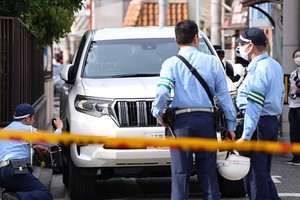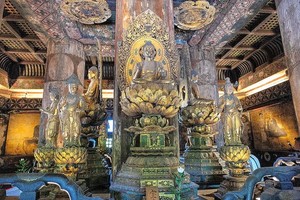By DAICHI ITAKURA/ Staff Writer
April 24, 2025 at 07:00 JST

Membership in yakuza gangs hit an all-time low of 18,800 by the end of last year, marking 20 consecutive years of decrease, the National Police Agency said.
It was the first time for the number to fall below 20,000 since the NPA began keeping records in 1958.
On the other hand, anonymous, ad hoc criminal groups known as “tokuryu,” whose members interact on social media, are cleaning up through scams and robberies--and becoming a growing social issue.
The number of known “tokuryu” members arrested for various crimes exceeded 10,000, topping arrests of gang members, the NPA announced on April 3.
The NPA believes that some gangs and tokuryu groups are working together to commit crimes.
By the end of 2024, police said full-fledged yakuza members totaled 9,900, down 500 from the previous year. In addition, quasi-members who don’t belong to any gang organization but are involved in their activities totaled 8,900, down 1,100.
Figures for yakuza members as well as quasi-members were both below 10,000 for the first time.
By group, the largest, Yamaguchi-gumi, headquartered in Kobe, saw a decrease of 500 members, bringing its total to 6,900. Sumiyoshi-kai, based in Tokyo’s Shinjuku Ward, ranked second with 3,200 members, down 300, and Inagawa-kai, headquartered in Tokyo’s Minato Ward, had 2,800 members, a drop of 100.
Gang membership has steadily declined since reaching a peak, 184,100, in 1963. The dramatic fall in numbers accelerated after the law on the prevention of unjust acts by organized crime group members took effect in 1992. The NPA cited strengthened crackdowns and society’s efforts to eliminate gang groups for the decrease.
On the other hand, tokuryu groups have become more active.
Last year, tokuryu groups were involved in a range of crimes, including a series of violent robberies in the Tokyo metropolitan area which took place last year, along with online investment fraud and romance scams. They were also involved in malicious night club activities, online casinos and fraudulent home reform businesses.
BOSSES ACCOUNT FOR ONLY 10% OF ARRESTS
Last year, 10,105 tokuryu members were arrested for crimes involving attempts to gain money. The figure compares with 8,249 gang member arrests.
The most common crime involved violation of the prevention of transfer of criminal proceeds law, notably over the sale of bank accounts, which led to 3,293 arrests. This was followed by 2,655 arrests for fraud, 991 for theft, 917 for violating anti-drug laws, and 348 for robbery.
Nearly 40 percent of the individuals who were arrested had applied for “yamibaito” dark part-time jobs that recruit perpetrators on social media with the promise of rich rewards.
Most of the arrested perpetrators were those who first got their hands on the fraudulent funds, while only about 10 percent of the arrests involved group leaders or people who gave instructions for carrying out the crimes.
In addition, the money generated by the criminal activity was often laundered, making it difficult to trace.
The NPA pointed to a connection between tokuryu and gang groups.
It noted cases where a crime syndicate has tokuryu groups under its umbrella, and gang members serve as executives or actively take part in those entities.
Sometimes gang and tokuryu members commit crimes together, and police believe that funds obtained by tokuryu groups often flow to organized gangs.
“The reality is that gang and tokuryu groups maintain certain relationships with each other and are committing a variety of crimes together to obtain funds,” Yoshinobu Kusunoki, the commissioner-general of the NPA, told an April 3 news conference.




















Information on the latest cherry blossom conditions. (The page is in Japanese. Please right click to use your browser’s translation function.)
A series based on diplomatic documents declassified by Japan’s Foreign Ministry
Here is a collection of first-hand accounts by “hibakusha” atomic bomb survivors.
Cooking experts, chefs and others involved in the field of food introduce their special recipes intertwined with their paths in life.
A series about Japanese-Americans and their memories of World War II